Lower back pain most commonly affects people over the age of 35. In the vast majority of cases, the disease is associated with a deformity of the vertebrae and its consequences. A timely visit to the doctor will speed recovery, since the symptoms and treatment of osteochondrosis of the lumbar spine are related.
The further the disease progresses, the more serious its consequences, the more difficult the process of restoring health.
Signs and symptoms of osteochondrosis of the lumbar spine
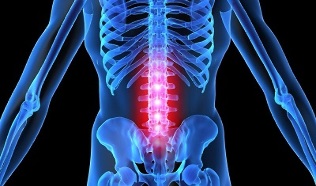
The lumbar spine is located between the sacrum and the thoracic region and consists of five vertebrae that are connected by intervertebral discs.
The development of osteochondrosis means the wear and tear of the intervertebral discs, which play a shock-absorbing role when the spine is stressed. The base of the discs is a gel-like mass, protected by a dense ring of fibers and cartilage tissue, and the interior is filled with a liquid nucleus pulposus.
With increasing stress on the vertebrae, the elasticity and flexibility of the intervertebral discs and their height are lost, and microcracks form in the annulus fibrosus, which ultimately lead to a rupture and damage to the nucleus pulposus.
The tissue destruction is accompanied by pinching of the nerve roots on both sides of the vertebra and causes severe pain.
The main signs of lumbar osteochondrosis:
- back pain;
- tiredness and depression;
- weakness or excessive muscle tension;
- Loss of sensation in the limbs, buttocks, or thighs;
- sharp or aching pains and cramps in the lumbar region, often radiating to the legs;
- Violation of the motor function.
Against the background of serious vertebral injuries to the lumbar spine, other symptoms are observed, mostly functional disorders of other organs - the urinary and reproductive systems, the gastrointestinal tract.
Causes of occurrence
Like most musculoskeletal disorders, osteochondrosis can develop for many reasons. Some of them are rooted in lifestyle and diet, while the other part develops against the background of the physiological characteristics of the body.
Very often the treatment of osteochondrosis of the lumbosacral spine is necessary in athletes whose back is exposed not only to constant loads, but also to periodic injuries.
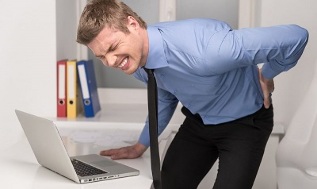
The second category of vulnerable people, people who spend a lot of time in one position because of their job - teachers, hairdressers, cooks, loaders, waiters, programmers, office workers and drivers.
Among other reasons for the development of pathology:
- overweight;
- metabolic disorder;
- wrong posture, bend over;
- genetic predisposition;
- injuries;
- bad habits;
- lack of useful microelements and vitamins in the diet;
- abnormal development of the musculoskeletal system, flat feet;
- hypothermia;
- lack of mobility, static;
- frequent stress.
All of the above factors can affect the elasticity of the intervertebral discs, as they contribute to impaired blood flow or the occurrence of nutrient deficiencies in the vertebral tissues.
The vertebrae can fulfill their functions as long as the tissue is renewed regularly. In the case of malnutrition of the vertebral tissue, be it a lack of blood circulation or problems with the metabolism, the regeneration processes slow down or stop completely. So there is a dehydration and dystrophic change in the cartilage and the fibrous ring of the vertebrae.
Degree of osteochondrosis of the lumbar spine
Depending on the extent of the spinal lesion, there are four stages of development of osteochondral processes that manifest themselves in stages over the course of the disease.
First degree
Pathological processes in the spine begin long before their first clinical manifestation. The intervertebral discs become less elastic due to the loss of moisture. The height of the slices remains normal. The patient feels uncomfortable in the lumbar region.
Second degree
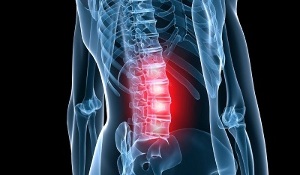
Against the background of a lack of moisture, microcracks appear in the annulus fibrosus and tissue inflammation occurs.
The hook-shaped processes of the vertebrae gradually increase. Seals develop in the cartilage.
A patient complains of back pain radiating to the legs or the groin area. A limitation of the motor skills is possible. Malfunctions occur in the work of internal organs.
Third degree
The integrity of the annulus fibrosus is broken, the intervertebral disc protrudes and forms an inguinal hernia. The vessels and nerve endings are compressed. There are muscle spasms, dysfunction of the pelvic organs, sensory disorders of the lower extremities, persistent sciatic attacks.
Fourth degree
The most difficult, untreatable stage in the course of the disease. Due to the complete destruction of the intervertebral discs, scars form in their place. The vertebrae approach as closely as possible and gradually deform. With the development of spinal cord compression, paralysis of the lower extremities is possible.
If timely treatment of osteochondrosis of the lumbar spine is not provided, the destruction of the vertebrae progresses and can lead to disability.
Diagnosis
To identify a disease and make an accurate diagnosis, neurologists use a number of measures - anamnesis, physiological examination and instrumental studies.
Take anamnesis
Enables the investigation of patient complaints:
- cause for concern;
- place of discomfort;
- duration and intensity of unpleasant sensations;
- the duration of the illness;
- possible causes of the disease;
- frequency of exacerbations;
- factors that lead to exacerbations;
- factors that improve well-being.
In addition, the doctor examines information about the patient's lifestyle, diet, work and rest, the presence of bad habits, hereditary factors and trauma.
Physiological examination
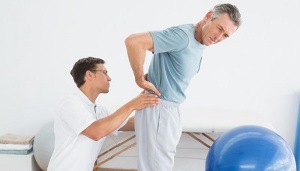
Is performed to identify pathological changes and to make a preliminary diagnosis.
During the examination, the doctor evaluates the patient's motor skills - gait, posture, amplitude and range of motion. The method of palpation examines the condition of the muscles - tone, size, volume, the presence of spasms.
Sets the sensitivity level with a slight tingling sensation. The zones of pain radiation can be identified by tapping with a hammer.
Hardware studies
In order to get complete and accurate information about the location of the pathology and the degree of tissue damage, doctors use research with various types of medical equipment.
radiography.The examination of the lumbar spine by means of X-rays makes it possible to determine the anatomical parameters of the vertebrae and intervertebral discs, the tendency for the holes between the bases to narrow and the presence of bone growth.
Tomography.The use of electromagnetic waves provides a display of the image of the examined area on the screen for further study and analysis of the condition of the vessels that supply the tissues of the spine, nerve processes and intervertebral discs.
CT.X-rays of several segments of the spine are taken. The image is displayed on the monitor to determine the nature of the changes in the vessels, membrane of the vertebrae and spinal cord, as well as marginal growth.
For differential diagnosis, various types of research are used to exclude pathologies of other body systems.
Treatment of osteochondrosis of the lumbosacral spine
The duration and features of treatment for lumbosacral osteochondrosis depend on the results of diagnostic measures. In the early stages of the development of the disease, conservative treatment is indicated. Surgical intervention is used for more complex lesions of the spine.
The optimal therapeutic effect is achieved through a complex therapy that includes the use of topical drugs, physiotherapy, massage and fitness exercises.
Medicines
For the relief of symptoms, nonsteroidal drugs are prescribed for internal and external use - tablets, injections, ointments. In addition, chondroprotectors, neuroprotectors, diuretics, vitamins and muscle relaxants are used.

Enable medication:
- eliminate pain;
- relieves inflammation;
- relax muscles;
- restore the destroyed cartilage tissue;
- improves blood circulation;
- reduce swelling;
- increases physical activity;
- normalizes the nutrition of the brain.
For acute pain, a novocaine blockade is used, which has an immediate effect.
Folk Remedies
Treatment with folk methods is effective as a complement to drug therapy. The main methods of traditional medicine are based on the use of plant materials, animal products and chemicals.
On the basis of various components, ointments and compresses, decoctions and infusions are made, which are used for internal and external use, as well as for medicinal baths.
Physiotherapy for lumbar osteochondrosis
Physiotherapy procedures are an excellent way to restore the motor functions of the spine after osteochondrosis.
The most important physiotherapeutic methods are:
- Electrotherapy- exposure to weak electrical currents to improve blood circulation in tissues;
- Magnetotherapy- using the properties of the magnetic field to restore tissue at the cellular level;
- Laser therapy- complex activation of biological processes in vertebral tissues and nerve endings;
- Shock wave therapy- improvement of microcirculation and metabolic processes in the affected tissues through exposure to a sound wave;
- Balneotherapy- use of the healing properties of mineral water.
Physiotherapy procedures not only increase the effectiveness of drug treatment many times over, but also contribute to the healing and strengthening of the entire body.
Massage for osteochondrosis of the lumbar spine
Attending massage treatments is one of the most pleasant and effective methods of treating osteochondrosis.
With massage therapy:
- eliminates muscle spasms;
- improves the blood supply to the affected areas;
- improves lymph flow;
- restores muscles that have suffered atrophy;
- removes the restriction of mobility.
Massage is prescribed when pain syndromes are eliminated.
Remedial gymnastics
The main task of exercise therapy for osteochondrosis is to restore and correct the functionality of the spine. However, you can only attend classes after the symptoms of the exacerbation are eliminated.
The most effective methods of medical gymnastics are:
- Load;
- visit to the gym;
- water therapy, swimming.
A tire can be used for sports at home. Some doctors recommend yoga classes to their patients to help restore flexibility to the spine.
Exercises to worsen lumbar osteochondrosis
All exercises for osteochondrosis should be done slowly and without sudden movements.
To strengthen the muscles that support the vertebrae, appropriate exercises are performed while lying on your stomach. In this case, the arms are stretched slightly, but pulled up without tension. Repeat 4 times.
surgery
An operation is used to treat the spine in particularly difficult cases - with significant neurological disorders and loss of control of the chair.
During the operation, the cause of the disease is removed and measures are taken to stabilize the spine. The postoperative period lasts several months.
Why is lumbar osteochondrosis dangerous?
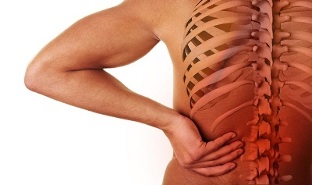
Degenerative changes in lumbar osteochondrosis contribute to the development of many life-threatening diseases. Against the background of an intervertebral hernia, protrusions, lumbago and sciatica appear.
Further progression of the disease can lead to the herniated disc and the formation of spinosis. In addition to the severe pain that accompanies the pathology, a person's motor skills are disturbed to the point of complete loss. Lower extremity paralysis develops.
Death is inevitable when the lining of the spinal cord is severely damaged.
Prevention
In order to avoid damaging changes to the spine, you need to follow a healthy lifestyle:
- do sports - swimming, tempering;
- , to follow the right balanced, nutritious diet;
- eliminates bad habits;
- keep your posture;
- supports the spine while sleeping with an orthopedic mattress.
It is also advisable to avoid hypothermia and heavy lifting. Women are advised not to wear high-heeled shoes frequently.
You can keep your lower back healthy if you adapt your lifestyle and don't forget the importance of physical activity.







































